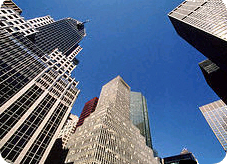
New York boasts the most extensive and one of the oldest transportation infrastructures in the country. Engineering difficulties because of the terrain of the state and the unique issues of the city brought on by urban crowding have had to be overcome since the state was young. Population expansion of the state generally followed the path of the early waterways, first the Hudson River and then the Erie Canal. Today, railroad lines and the New York State Thruway follow the same general route. The New York State Department of Transportation is often criticized for how they maintain the roads of the state in certain areas for the fact that the tolls collected along the roadway have long passed their original purpose. Until 2006, tolls were collected on the Thruway within The City of Buffalo. They were dropped late in 2006 during the campaign for Governor (both candidates called for their removal).
The Bear Mountain Bridge crossing the Hudson River.
The Bear Mountain Bridge crossing the Hudson River.
New York City is home to the most complex and extensive transportation network in the United States, with more than 12,000 iconic yellow cabs, 120,000 daily bicyclists,[8] a massive subway system, bus and railroad systems, immense airports, landmark bridges and tunnels, ferry service and even an aerial commuter tramway. About one in every three users of mass transit in the United States and two-thirds of the nation's rail riders live in New York and its suburbs.
Three suburban commuter railroad systems enter and leave New York City, including the Long Island Rail Road, MTA Metro-North, the PATH system and five of NJTransit's rail services.
Besides New York City, many of the other cities have urban and regional public transportation. Syracuse is the smallest city in the U.S. to have a commuter rail line, known as OnTrack. Buffalo also has a Subway line, sometimes called a Lightrail System run by the NFTA, and Rochester had a subway system, although it is mostly destroyed. Only a small part exists under the old Erie Canal Aquaduct.
Portions of the transportation system are intermodal, allowing travelers to easily switch from one mode of transportation to another. One of the most notable examples is AirTrain JFK which allows rail passengers to travel directly to terminals at Kennedy Airport.
Sunday, February 18, 2007
Transportation
Publicada por
blogger
em
8:04 AM
![]()
Subscribe to:
Post Comments (Atom)

No comments:
Post a Comment